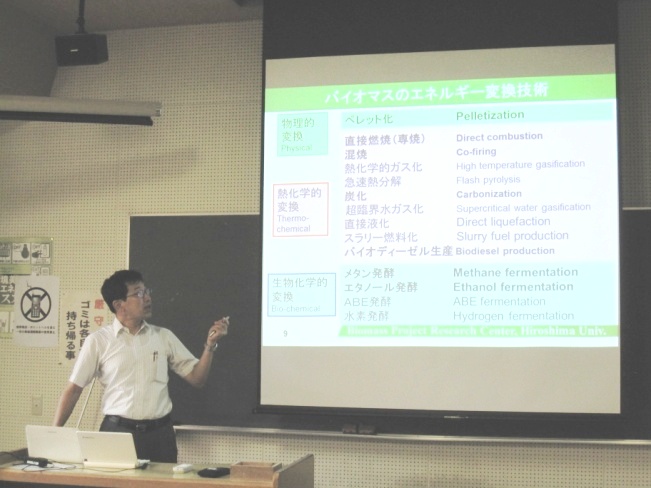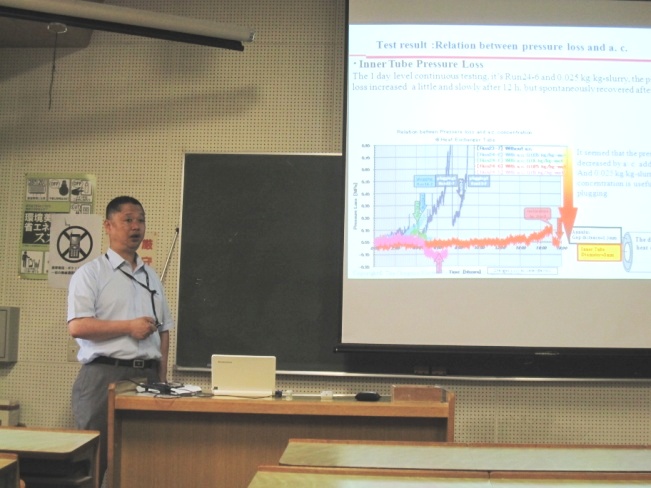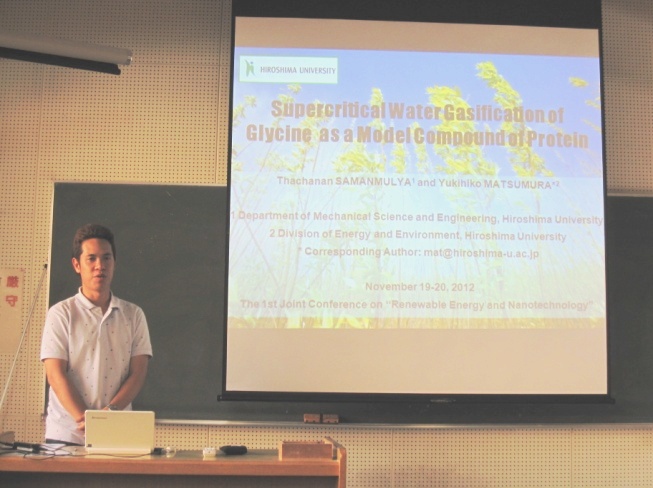|
On June 26, 2013, the 10th Biomass Evening Seminar was held at Graduate School of Engineering, Hiroshima University.
Biomass Project Research Center, Hiroshima University, and HOSTY Association are co-organizing the Hiroshima University Biomass Evening Seminar. This seminar covers topics from the fundamentals of biomass to the latest information so that it can contribute the activities on biomass in this district.
Yukihiko MATSUMURA
Professor, Faculty of Engineering

|
|
"The result of 1 day level continuous testing on supercritical water gasification process with shochu residue"
Yasutaka WADA
Chugoku Electric Power Co.,Inc. Energia research institute.
 The supercritical water gasification (SCWG) of biomass holds promise as a technology to convert biological waste into valuable, environmentally friendly energy. Rather than eliminating the high water content in wet biomass, SCWG is suitable for energy conversion of wet biomass. Long-time continuous operation with large-sized device is important for practical realization, but it has not been reported so far. We advance the study of long-time continuous operation of pilot plant which has 1 t / day treatment capacity, and report very good results. The supercritical water gasification (SCWG) of biomass holds promise as a technology to convert biological waste into valuable, environmentally friendly energy. Rather than eliminating the high water content in wet biomass, SCWG is suitable for energy conversion of wet biomass. Long-time continuous operation with large-sized device is important for practical realization, but it has not been reported so far. We advance the study of long-time continuous operation of pilot plant which has 1 t / day treatment capacity, and report very good results.
Activated carbon is used as a gasification catalyst in SCWG. We suggested suspending a fine activated carbon catalyst in feedstock and feeding to the SCWG reactor. And we used Shochu residue for feedstock. In a study using activated carbon was increased pressure loss in the heat exchanger jacket (treated water). This is probably due to the retention of coarsened activated carbon. In a study using no activated carbon, heat exchanger tube (feedstock) was blocked by tar. So we conducted gasification test using Shochu residue to solve plugging with examining about the efficacy of catalyst concentration. The data confirms that some activated carbon concentration helps to prevent plugging. So we tried 1 day level continuous test, and succeeded.
|
“Supercritical Water Gasification of Glycine as a model compound of Protein”
Thachanan SAMANMULYA
D2 Student,Graduate School of Engineering, HU
 Supercritical water gasification of biomass is a promising technology for producing combustible gas such as H2 and CH4. Nonetheless, less by products is found concurrently during supercritical water gasification. To elucidate reaction mechanism of supercritical water gasification of biomass, correlation between kinetic rate and temperature is useful to classify radical and ionic reactions which are important role of the supercritical water gasification. Supercritical water gasification of biomass is a promising technology for producing combustible gas such as H2 and CH4. Nonetheless, less by products is found concurrently during supercritical water gasification. To elucidate reaction mechanism of supercritical water gasification of biomass, correlation between kinetic rate and temperature is useful to classify radical and ionic reactions which are important role of the supercritical water gasification.
Sewage sludge, which usually contains plenty of water and organics such as carbohydrate, protein and fattiness, is suitable to be gasified for hydrogen production. Utilization of model compounds is effective to evaluate the kinetic parameter of supercritical water gasification. In this work, glycine was chosen as model compound of protein. The glycine solution (1.0-5.0 wt%) was gasified in a tubular reactor at temperature of 500 to 650oC and pressure of 25 MPa. We are also vary residence time (63-188 s) and use activated carbon (0.5 wt%) as a catalyst in order to improve gasification efficiency. The identification and quantification of gaseous product were analyzed (GC) and also water-soluble products (TOC) were examined. Based on the experimental results, proposed reaction network of the carbon gasification efficiency was developed for the supercritical water gasification, by assuming the first-order reaction. The result showed elevated temperature and catalyst addition would be required for the gasification of the high concentration of feedstock. The gasification rate following Arrhenius behavior is promoted by high temperature and pressure conditions.
Key words : Biomass, Supercritical Water Gasification, Glycine, Protein
|
|
Machi KANNA
Assistant Professor, Institute of Engineering
|
[Inquiries about this article]
Thermal Energy Laboratory, Graduate School of Engineering
Y.NAKASHIMA
Mail: y4naka [AT] hiroshima-u.ac.jp
(Please replace [AT] with @)

 Home
Home
 The supercritical water gasification (SCWG) of biomass holds promise as a technology to convert biological waste into valuable, environmentally friendly energy. Rather than eliminating the high water content in wet biomass, SCWG is suitable for energy conversion of wet biomass. Long-time continuous operation with large-sized device is important for practical realization, but it has not been reported so far. We advance the study of long-time continuous operation of pilot plant which has 1 t / day treatment capacity, and report very good results.
The supercritical water gasification (SCWG) of biomass holds promise as a technology to convert biological waste into valuable, environmentally friendly energy. Rather than eliminating the high water content in wet biomass, SCWG is suitable for energy conversion of wet biomass. Long-time continuous operation with large-sized device is important for practical realization, but it has not been reported so far. We advance the study of long-time continuous operation of pilot plant which has 1 t / day treatment capacity, and report very good results. Supercritical water gasification of biomass is a promising technology for producing combustible gas such as H2 and CH4. Nonetheless, less by products is found concurrently during supercritical water gasification. To elucidate reaction mechanism of supercritical water gasification of biomass, correlation between kinetic rate and temperature is useful to classify radical and ionic reactions which are important role of the supercritical water gasification.
Supercritical water gasification of biomass is a promising technology for producing combustible gas such as H2 and CH4. Nonetheless, less by products is found concurrently during supercritical water gasification. To elucidate reaction mechanism of supercritical water gasification of biomass, correlation between kinetic rate and temperature is useful to classify radical and ionic reactions which are important role of the supercritical water gasification.